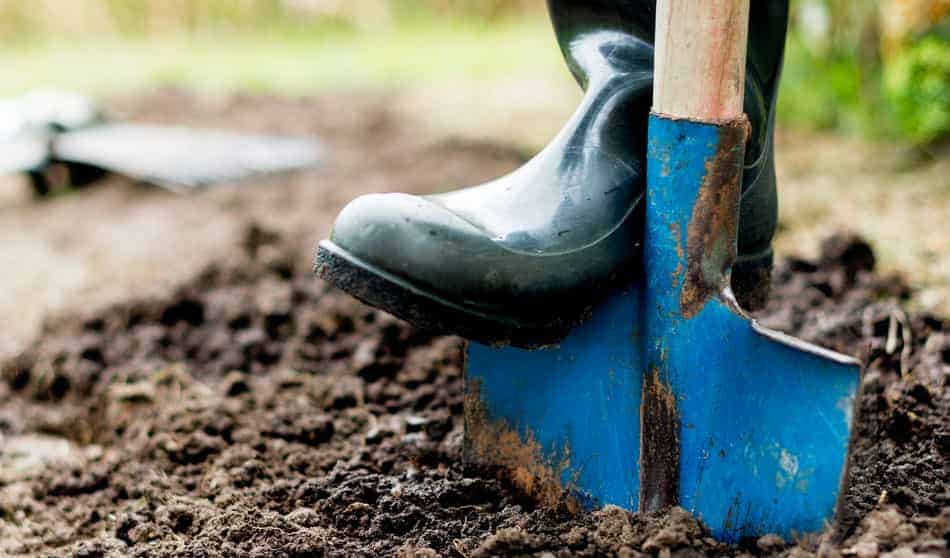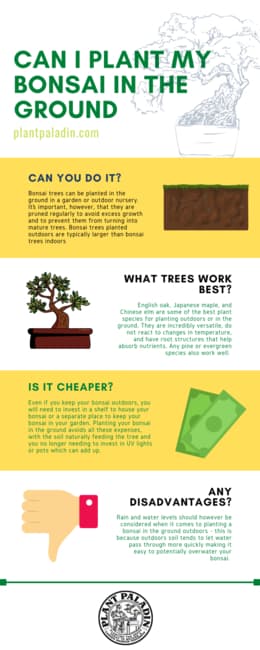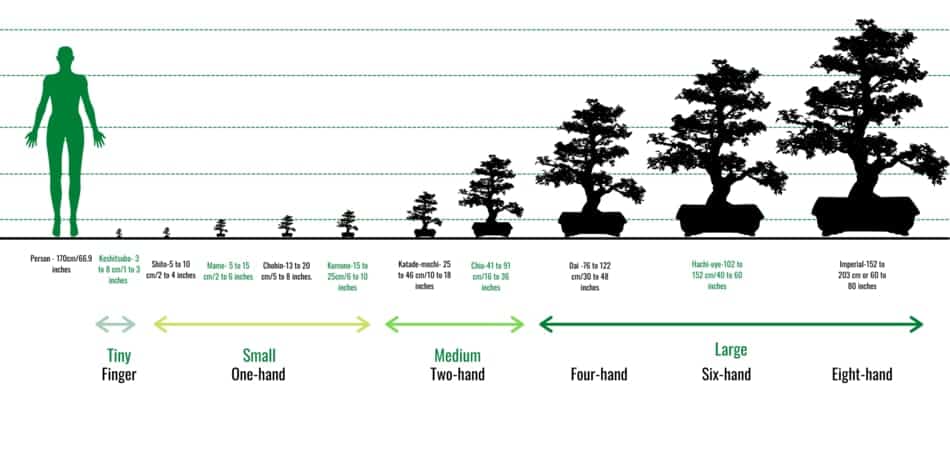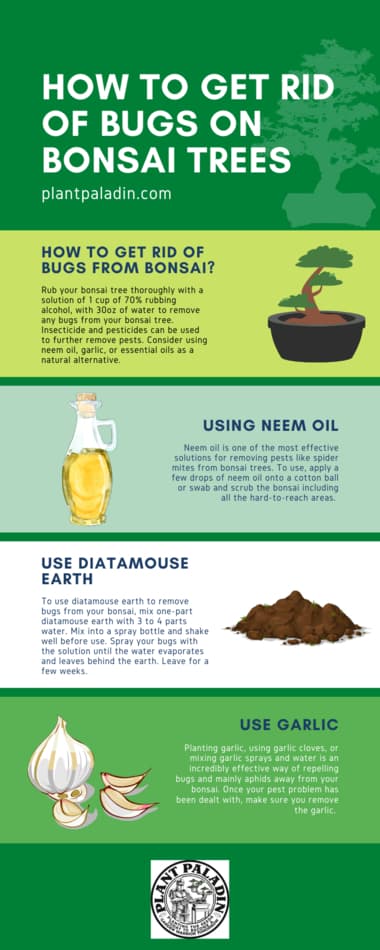This website is supported by its readers. If you click one of my links I may earn a commission. I am also a participant in the Amazon affiliates program and I will also earn a commission from qualified purchases.

So I’m looking to move from my tiny one-bedroom flat to a lovely house with a reasonable sized garden within the next month and so one of the questions I’ve had is can you plant a bonsai tree in the ground?
Bonsai trees can be planted in the ground in a garden or outdoor nursery. It’s important, however, that they are pruned regularly to avoid excess growth and to prevent them from turning into mature trees. Bonsai trees planted outdoors are typically larger than bonsai trees indoors
So what are the considerations you need to know before planting your bonsai in the ground? And which plant species work best as planted bonsai trees? Keep reading to find out more!
Just a quick heads up, over the past three years of running Plantpaladin, hundreds of people have asked for product recommendations. As such, You can find my favorite indoor bonsai tree here (link takes you to Bonsaiboy), my favorite outdoor bonsai tree (link takes you to Bonsaiboy), or have a look at all the products I recommend here.
Can you plant a bonsai tree in the ground?
One of the things that those of us lucky enough to have a garden or live in an area with loads of outdoor space is if we should plant our bonsai in the ground.
After all, the whole point of bonsai is typically to master a plant in a pot – so isn’t planting your bonsai in the ground outdoors, just the same as planting a tree?
Yes and no.
You see whilst planting your bonsai in the ground starts off exactly the same as you would a tree, with effective pruning, maintenance, and care your planted outdoor bonsai can be amongst the strongest of your bonsai tree collection.
This works especially well if you would like to grow an emperor bonsai – the largest of all bonsai size classifications.
Key points
I always find the following points work the best whenever I ask myself a question.
- Bonsai trees are not fragile, especially trees that are under 150 years old, meaning they can easily be planted outdoors
- Planting a bonsai tree outdoors allows it to gain natural nutrients that would not be available were you to keep them in a pot or indoors.
- For hundreds of years, people in China and Japan used to keep bonsai trees planted in the ground.
- Planting bonsai in the ground also means that the roots will be able to grow unimpeded, leading to a healthier bonsai with a fuller set of leaves. This is crucial to designing an aesthetically pleasing bonsai
- Planting a bonsai in the ground outdoors will also mean that it will be less susceptible to changes in temperature – bonsai kept indoors usually becomes more reactionary to subtle changes in temperature.
- Rain and water levels should however be considered when it comes to planting a bonsai in the ground outdoors – this is because outdoors soil tends to let water pass through more quickly making it easy to potentially overwater your bonsai.
To help explain more, I’ve put together an infographic below that helps summarize this:

Now planting your bonsai outdoors will depend very much on your own situation, so let’s explore the advantages and disadvantages of planting your bonsai in the ground.
Advantages of planting a bonsai tree in the ground
So for me, planting a bonsai outdoors has way more advantages than disadvantages. The main however being the following:
It can help the environment
A recent study by several key beekeepers found that 50 billion bees – which is more than 7 times the world population – were wiped out in the winter of 2019.
Pair this up with the fact that every decade we lose around 9% of the global insect population – the environment is in a bad way.
Doing something as simple as planting a bonsai tree in the ground outdoors, especially if your bonsai has fruit or flowers, will help attract valuable insects to pollinate your plants and trees which is essential for our ecosystem.
On top of this, having any form of greenery in your garden, especially if you live near a busy road or high traffic area can help remove some of the carbon dioxides in the air, which is also contributing to global warming and climate change.
It makes your garden more aesthetically pleasing
Another fantastic advantage of planting your bonsai in the ground outdoors is that it can help create a centerpiece in your garden – making it more aesthetically pleasing.
You see if you keep your bonsai in pots. It’s likely that you will need to keep them in a nursery or on a shelf in the garden if you do keep them outdoors.
Having a bonsai planted in the ground avoids the need for pots or shelves which can eat into valuable space and instead create a Centrepoint you can design your garden around.
It can cost less money
One of the major disadvantages of keeping your bonsai indoors can be the cost.
Creating the right soil mix, bonsai pots, investing in UV lights for the winter, fertilizer and general plant food can all start to add up should you keep your bonsai indoors.
Even if you keep your bonsai outdoors, you will need to invest in a shelf to house your bonsai or a separate place to keep your bonsai in your garden.
Planting your bonsai in the ground avoids all these expenses, with the soil naturally feeding the tree and you no longer needing to invest in UV lights or pots which can add up.
Your bonsai will grow bigger
If you are looking to create a giant bonsai such as an emperor-sized bonsai (typically two meters or the largest size classification available) then one of the best things you can do is plant your bonsai in the ground.
This will let your roots grow unimpeded soaking up all the natural nutrients from the soils, without being limited by a pot or soil.
Growing a giant bonsai-like emperor can only really happen when you have a lot of room and with a lot of us not having a dedicated large bonsai garden, planting a bonsai in the ground is the next best option.

Your bonsai will be healthier overall
Bonsai trees that are grown outdoors are typically stronger and more resilient than indoor bonsai.
This is because indoor bonsai typically struggle to get enough light, that is essential for photosynthesis.
On top of this, most bonsai, regardless of if they are kept outdoors or indoors, usually have weak roots which are impeded due to being kept in a pot too small.
Even after repotting, this is usually only a temporary solution until the plant needs to be repotted again.
Having strong roots is essential to passing essential nutrients through your tree and so planting them in the ground will mimic your bonsai’s natural environment as much as possible
It’s also common to damage deadwood in your bonsai through things like Jin or Sabamiki and so having a strong root system will ensure you won’t have to worry about your plant not recovering from any damage.
Disadvantages to planting a bonsai tree in the ground
Now while I feel planting a bonsai in the ground is worthwhile, I would recommend understanding the other side, and some of the potential disadvantages to planting your bonsai outdoors.
It requires more pruning
As your bonsai will be planted in the ground, not constricted by a pot or soil, then it becomes super easy for your small bonsai tree to grow into a mature regular tree.
It is important to prune and trim any excess branches and growth as soon as possible.
With the excess nutrients, it’s not uncommon for some plant species to grow rapidly when planted outdoors in the summer months, and so you will find that you will be doing a lot more pruning than if your bonsai was kept in a pot or indoors.
It can be easy to overwater
When bonsai are kept indoors, it is very easy to manage the amount of water your bonsai needs.
After a while, you will find out the perfect amount and not have to worry about overwatering your bonsai.
The same goes if you keep your bonsai outdoors but leave it in a traditional bonsai plant pot.
Keeping your bonsai in the ground makes this process more challenging
First, you will not be able to see if the soil your bonsai is planted in is passing the water through, whilst also holding enough water to hydrate your plant – this is a fine balance that is essential for plant health
Secondly, planting your bonsai in the ground in rainy climates such as the UK, means that it can be very easy to start overwatering your bonsai which can lead to things like root rot, white spots, or white powder on your bonsai.
You can burn your tree
Another potential issue with keeping your bonsai in the ground is the impact of the sun.
Whilst bonsai trees need sunlight for food and photosynthesis, If you live in a very hot sunny climate, in the summer months you can potentially burn your bonsai, especially if it is not getting enough water.
Sunlight can cause serious problems if you are using a bug repellent such as neem oil which can increase the chances of burning your plant
On top of this if you plant your bonsai in the ground in a sunny climate it can be easy to dry out your soil causing your bonsai to start shedding its leaves as a way to save itself.
More likely to have insect infestations
Like an epic battle for the ages ( I’m looking at you Godzilla and King Kong) bonsai owners battling insect infestations are part of the parcel.
Planting your bonsai in the ground outdoors means that it is more likely you will get pests such as whiteflies, scale, aphids, and fungus gnats in and around your tree.
As your bonsai will be planted in the ground you’re also much more likely to get other bugs such as worms or snails attacking your tree which is a lot less common indoors.
Now to learn more on how to remove bugs from your bonsai check out this blog post here.

Can be more difficult to winterize
Whilst this might not be a problem for most of you living in temperate climates such as the UK or USA, those of you living in locations that have more severe winters such as Canada or Russia, might struggle to winterize your bonsai.
Typically we winterize our plants near the end of October or six weeks from the worst part of the winter to avoid bonsai from dehydrating – storing them in things like bonsai cold frames.
If you were to plant your bonsai in the ground, you would need to replant it in an indoor cold frame or cover up the place where you keep your bonsai outdoors which can be a lot more time-consuming.
If you are in this scenario there are some ways to get around this by checking out my post on winterizing your bonsai.
They can eat into your garden space
Finally, if you were to plant your bonsai in the ground, it is much more likely regardless of how much pruning, defoliation, or general care you give your bonsai will be larger than if you were to leave it unwanted.
As such, it will take up a lot more room in your garden than it would when you leave your bonsai in a pot.
This can be frustrating especially if you only have a small garden space that you are working with.
It’s also important to take into consideration the length of your roots, especially if your bonsai is large.
This is because your roots might get into everything such as pipes or other items that can be found commonly in your garden.
| Advantages to planting your bonsai in the ground | Disadvantages to planting your bonsai in the ground |
| Helps the environment | Easy to overwater |
| Larger trees | Requires more pruning |
| More aesthetically pleasing | More insect infestations |
| Healthier trees | Harder to winterize |
| Larger bonsai | Eat into space |
Considerations before you plant a bonsai in the ground
Now before you pick up your shovel and plant your bonsai in the ground there are few final considerations you need to ask yourself
Water
As you will be planting your bonsai in the ground outdoors, understanding how much water your garden gets, both in winter and the summer months is essential to determine the success or failure of your bonsai.
Some tropical plants prefer being kept in wet climates whilst others such as succulents hate it.
Age
The older your bonsai is, the less likely it is to develop a full or mature root system and grow into a mature tree.
If you find your bonsai is relatively young, say under 40 to 50 years old, then I would avoid planting this in the ground as there is a much higher likelihood of your small bonsai turning into a monster tree.
Location
Understanding where you will place your bonsai, how much space you have, and where the perfect place for sunlight are all important to understand before you plant your bonsai in the ground.
If you find that you just don’t have enough room or have things like gutter or sewage pipes underground then it might be something you want to avoid.
Winterizing
Most bonsai trees are incredibly robust, however, if you live in a harsh climate, taking note of how you will winterize your bonsai when it is kept in the ground is super important.
Which plants species work best for plating a bonsai in the ground?
English oak, Japanese maple, and Chinese elm are some of the best plant species for planting outdoors or in the ground. They are incredibly versatile, do not react to changes in temperature, and have root structures that help absorb nutrients. Any pine or evergreen species also work well.
It’s important to note however that any bonsai species planted in the ground should be older than 50 years. This is because younger tree roots can mature into full-grown trees.
What do the experts say about planting a bonsai in the ground?
So when it comes to if you can plant your bonsai in the ground, I didn’t just want to give my knowledge but also wanted to get in touch with a few different experts.
Here is what they said:
“Planting a bonsai outdoors is perfectly fine so long as you understand it’s going to take a lot more work to manage and prune” – Garden Advice
“It’s a little more complicated but can be done” – Botanical Gardens
My top picks for the gear you will need!
So like I mentioned earlier, over the past three years of running PlantPaladin, hundreds of people have asked me for my recommendations on the best bonsai gear on the market.
Having spent thousands of dollars on bonsai items these past few years and tested at least 100 bonsai-specific products, I’ve listed my favorite products below – All of which I highly recommend and think you can get great value.
They can purchase directly by clicking the link to take them to Amazon.
Bonsai Tool Set: One of the significant challenges I’ve had is finding a toolset that was not only durable but didn’t break the bank. SOLIGT has recently developed a fantastic bonsai tool set that covers all the tools you need to trim, prune, and repot your trees. – You can grab it here.
Complete Bonsai Set: Many of you will want to grow your bonsai trees entirely from scratch, but finding the varicose seeds, pots, and other items in one place can be challenging. Leaves and Sole then have created a complete bonsai set that I’ve personally used that ticks all the boxes. You can grab it here.
Bonsai wire: The number of times I’ve run out of wire for my bonsai or purchased cheap bonsai wire that doesn’t do the job is embarrassing for me to admit. After a lot of trial and error, I found that using Hotop’s aluminum bonsai wire is one of the best options on the market. This can easily be used for both indoor and outdoor bonsai. You can grab it here.
